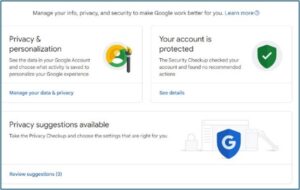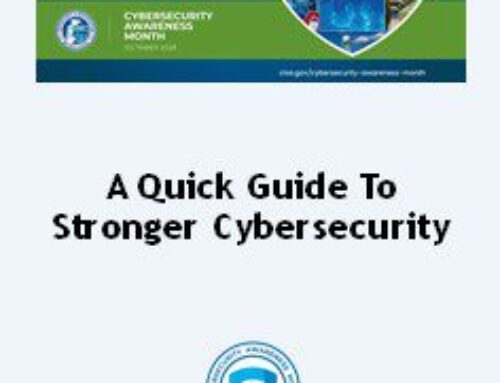How to give your Google account a quick ‘Security Checkup’
Do you have a Google account?
Chances are you do, even if you don’t realize it. Here are a few questions:
o Do you use Gmail?
o Do you sign into YouTube to watch videos?
o Do you use Google Maps?
o Do you use an Android smartphone?
o Do you use any Google service or product (https://about.google/products/) that isn’t listed above?
You have a Google account if the answer to one or more of those questions is yes.
As you can probably guess, Google accounts are among the most popular targets for hackers since Google collects and stores so much information about you.
That’s why ensuring your Google account is as secure as possible is crucial.
Auditing the security of an online account can be a real chore. Still, Google provides a handy ‘Security Checkup’ tool that makes it easy to quickly audit your Google account’s security.
Just follow the steps below for the device you’re using to launch Google’s Security Checkup and verify that your account is truly secure.
If you use Google in a web browser on a laptop or desktop computer:
 1 – Visit Google.com and sign into your Google account.
1 – Visit Google.com and sign into your Google account.
2 – Click your profile picture on the far-right side of the top menu bar.
3 – Click Manage your Google Account.
4 – In the left-hand pane, click security.
In the top section, you’ll see a brief description of your account’s security status.
5 – If Google has at least one recommendation regarding your account’s security, you’ll see a “Review security tips” link. Go ahead and click that link.
If Google considers your account secure, you’ll see a “See details” link. Go ahead and click it.
 6 – Review any tips that Google has provided for you. If it makes sense to you and your situation, you can now go ahead and make the recommended change. If not, you can skip it.
6 – Review any tips that Google has provided for you. If it makes sense to you and your situation, you can now go ahead and make the recommended change. If not, you can skip it.
7 – Click on the arrow for each section below to review the current settings for those sections and make any changes that you deem necessary.
If you use the Google app on a mobile device:
1 – Open the Google app and sign into your Google account.
2 – Tap your profile picture in the top-right corner of the screen.
3 – Tap Manage your Google Account.
4 – Scroll down and look for either a “Review security tips” link or a “See details” link, then tap the one you see.
5 – Review any tips that Google has provided for you. If it makes sense to you and your situation, you can now go ahead and make the recommended change. If not, you can skip it.
6 – Tap on the arrow for each section below to review the current settings for those sections and make any changes that you deem necessary.
Special thanks to Rick’s Daily Tips for this advice https://www.ricksdailytips.com/google-security-checkup
Connected Car Cybersecurity: Drive Safe Online
Cars have joined the Internet of Things, and with any connected device, you should follow some security best practices to keep your car’s system safe.
Today, many vehicles on the road are wheeled, portable computers. Estimates suggest new cars rolling off the assembly line have between 1,300 and 3,000 microchips inside. Some cars now even connect to the internet, which makes streaming music easy but opens the possibility for cyber threats.
What are Connected Cars?
Connected cars communicate digitally with other devices, infrastructure, and even other cars. Many such cars connect to the internet through a WLAN (Wireless Local Area Network), transmitted through radio waves.
Commonly, connected cars offer features like real-time navigation, entertainment systems, and proactive diagnostics. Often, modern cars become a hotspot for the people inside and allow for internet use. Along with connected devices, appliances, cameras, and toys, connected cars are part of the Internet of Things, the broad network of web-linked items that goes far beyond laptops and smartphones.
Why You Want to Secure Your Car’s Computers
The issue with IoT devices is that everything that connects to the internet has inherent vulnerabilities. This doesn’t just mean a hacker could take over your steering wheel. A cybercriminal might be able to infiltrate personal data on a laptop connected to your car’s unprotected wi-fi. Adopting some behaviors can fortify your vehicle and the rest of your IoT network.
 How to Choose Connected Cars Safely Factors to Consider
How to Choose Connected Cars Safely Factors to Consider
When shopping for a connected car, assess its cybersecurity features along with kicking the tires. Ensure that the vehicle provides a secure driving experience. Consider factors like:
- Device and software compatibility
- Included security features
- Ongoing technical support
Ask Questions
Along with asking about driving range, find out how a connected car collects, stores, and secures data. Inquire about:
- How does the car connect to the internet?
- What data does it collect?
- How does the car’s software receive updates?
Go Beyond the Default Password
Once you’re in the driver’s seat, take a few moments to improve the security of your car:
- Set unique, long, and complex passwords for every associated account, and change any default password
- Turn on multi-factor authentication (MFA) for any account that permits it
- Turn on automatic software updates to get the latest security features from the manufacturer
Stay Secure on the Road
Your connected car generates a massive amount of data. Safeguard this information by reviewing app permissions, deleting unnecessary data, and opting out of sharing when possible. Equip yourself with tools and techniques to monitor and control your connected car’s data and privacy. Virtual private networks (VPNs) add another layer of security to any connected device, for example. Incorporate these tools in your automobile’s toolkit along with socket wrenches and the spare tire. This way, you can safeguard your car’s network and protect the data it collects.
Connected cars provide a futuristic driving experience today. But to fully enjoy the bells and whistles of an internet-connected vehicle, you must adopt some security and privacy measures. Then you, your car, and your passengers can enjoy the information superhighway while driving down the actual highway.
https://staysafeonline.org/resources/connected-car-cyberesecurity-drive-safe-online/
Please mail the current infographic
Often 8 1/2" x 14 inches, we're happy to mail you one or enough for your whole team - just let us know.






